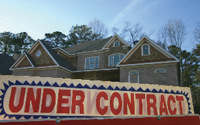Home Improvement
The New Orleans real estate market is on the rebound
 The steep price drops and rapidly rising foreclosure rates hurting many cities nationally aren’t catching on in the New Orleans market. In fact, many Realtors say the local market is regaining momentum nearly three years into the recovery from Hurricane Katrina.
The steep price drops and rapidly rising foreclosure rates hurting many cities nationally aren’t catching on in the New Orleans market. In fact, many Realtors say the local market is regaining momentum nearly three years into the recovery from Hurricane Katrina.
That’s in contrast to last year when many agents were struggling to find buyers. The New Orleans market had more than a year’s worth of inventory available and housing values were in flux due to the proliferation of unrenovated, damaged properties being sold. Now some properties in flooded neighborhoods are matching their pre-Katrina values.
“In some cases, like in Mid-City, we’re pretty much back to pre-storm values,” says Ken Huxen, an agent with RE/MAX New Orleans Properties. “That’s a good sign in terms of what’s going on, especially when you break it down into properties that are in excellent condition.”
For example, the average price for a three bedroom, two bath home in Mid-City in spring 2005 was $319,000, or $128 per square foot. The average price for the comparable time period in 2008 is roughly $283,000, but the square foot average is back to $128, Huxen says.
“We’ve done a pretty good job at coming back,” says Latter & Blum President Arthur Sterbcow, noting that sales volumes at his company have rebounded to 2004 levels even though the population for the metropolitan area has fallen to roughly 1.1 million from 1.3 million before the storm.
On average, home values are still 38 percent higher than they were five years ago, he says.
Sterbcow says the local market has been resilient, but threats from the national housing slide are beginning to have an impact in one area: mortgage lending. Because so many banks and investment funds had to write off losses from investments in risky mortgage loans, the entire industry is tightening credit restrictions. That means interest rates and fees are higher for applicants without stellar credit. Buyers must have solid credit scores, proof of income and, in many cases, at least a 20 percent down payment to qualify for a loan.
“Folks that we would normally have sold a home to a year ago can’t qualify for a loan,” Sterbcow says. “It is dramatically hampering our recovery.”
Sterbcow was part of a group lobbying Congress to require Fannie Mae and Freddie Mac—two of the nation’s largest sources of financing for residential mortgages—to ease credit restrictions and fees tied to fixed-rate mortgages.
Rick Crozier, vice president for Gul
Rick Crozier, vice president for Gulf Coast Bank & Trust, says the industry is back to old-school, traditional lending practices. That means no more sub-prime mortgages
or stated-income loans, where buyers did not have to provide proof of income.
“You’ve got to have income, and you’ve got to have assets. You can’t just state your income and state your assets,” he says. “We’re into logical lending. And that’s the key. We’re not going to make a loan that doesn’t make sense.
He says that even buyers with what once was considered “good” credit scores are finding themselves having to jump through hurdles to buy a home. Good credit for lenders has risen to a credit score between 680 to 850, whereas before the threshold started around 620.
“You want to keep your credit scores above 680 before buying a home,” he says.
Crozier says that one silver lining in the Katrina aftermath is that flood and homeowners insurance settlements wiped the slate clean for many homeowners who might have found themselves at risk when rates for adjustable rate mortgages rose. While many markets have seen foreclosures rates above 10 percent, that isn’t the case in New Orleans.
“If you look at the real estate industry, it’s on its knees right now, but New Orleans real estate industry is actually really vibrant.”
